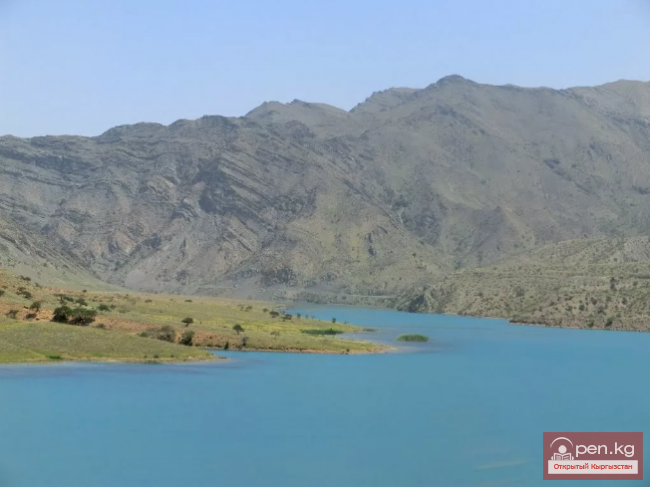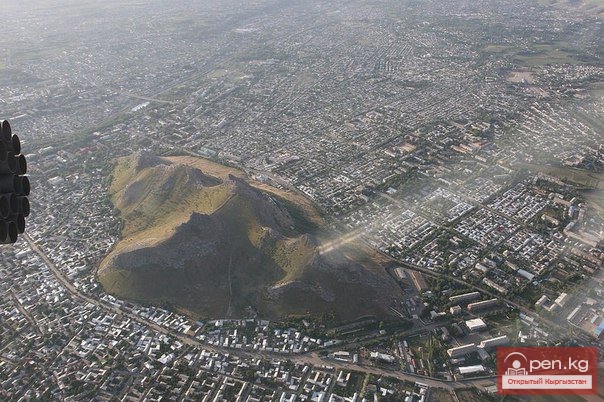
Classification of Arrowheads
A particular interest is presented by a small collection of medieval weapons, gathered over many years of field research in Kyrgyzstan by I.K. Kozhomberdiev. It consists of six iron arrowheads. Based on their cross-section and the shape of the blade, they can be classified into several groups and types.
Group I. Triangular-three-bladed arrowheads.
Type I. Elongated triangular. Includes 1 specimen from the Kum-Aryk site in the Chui Valley. The length of the blade is 6 cm, the width of the blade is 1.2 cm, the length of the tang is 4.3 cm. The arrowhead has a sharp triangular point, with gently expanding sides, straight shoulders, and a stop. There are narrow notches on three faces from the shoulders to the middle of the blade (Fig. 1,1).
Group II. Quadrangular arrowheads.
Type I. Elongated pentagonal. Includes 1 specimen from the Tortkul site in the Chatkal River valley. The length of the blade is 3.5 cm, the width of the blade is 1 cm, the length of the tang is 1.3 cm. The arrowhead has a sharp broken point, parallel sides, and straight shoulders with a stop (Fig. 1,2).
Type 2. Warhead. Includes 1 specimen from the Chon-Aryk site in the Ketmen-Tube valley. The length of the blade is 5 cm, the width of the blade is 1 cm, the length of the tang is 4.5 cm. The arrowhead has a sharp point, a distinct warhead, an elongated neck, and a stop (Fig. 1, 3).
Group III. Rhombic arrowheads.
Type I. Warhead. Includes 1 specimen from the Chon-Kemin site in the Chui Valley. The length of the blade is 5.8 cm, the width of the blade is 1.4 cm, the length of the tang is 3.3 cm. The arrowhead has a sharp point, a distinct warhead, an elongated neck, and a stop (Fig. 1, 4).
Group IV. Rectangular arrowheads.
Type I. Warhead tomars. Includes 1 specimen from the Tortkul site in the Chatkal River valley. The length of the blade is 4.3 cm, the width of the blade is 1 cm, the length of the tang is 4 cm. The arrowhead has a blunt point, a distinct warhead with an elongated neck, and a stop (Fig. 1, 5).
Group V. Flat arrowheads.
Type I. Sectoral. Includes 1 specimen from the Kum-Aryk site in the Chui Valley. The length of the blade is 6.5 cm, the width of the blade is 3.5 cm, the length of the tang is 4.5 cm. The arrowhead has a rounded point, gently sloping shoulders, and a stop (Fig. 1, 6).
Despite their small number, the presented series significantly complements the set of medieval arrows from the Pre-Tian Shan region, known from previous publications. Previously, in Turkic monuments of the Talas Valley, three-bladed arrowheads with an elongated rhombic shape of the blade were discovered, and in Turkic monuments on the territory of Kyrgyzstan, three-bladed arrowheads with elongated hexagonal, elongated rhombic, elongated triangular, and warhead blades were found; three-sided arrowheads with warhead blades; rhombic arrowheads with warhead blades.
From the series under consideration, the elongated triangular three-bladed and elongated pentagonal arrowheads can be attributed to the Turkic period. Both groups derive from corresponding prototypes that existed in the Kenkol culture. In particular, the Kenkol people had similar forms of triangular-three-bladed and quadrangular arrows with somewhat different blade designs. Overall, the complex of arrowheads from the Turkic period in Kyrgyzstan, despite known differences, is comparable to the Kenkol complex. In both complexes, among non-armored arrows, three-bladed types prevail, and all three types of Turkic arrows correspond to Kenkol types. Among armored arrows, the triangular-three-bladed and triangular types find analogies in Kenkol arrows. Both complexes also include quadrangular types, whose shapes are similar but not identical. Only the rhombic arrows of the Turks do not have prototypes in the Kenkol complex. Both complexes are similar in the ratio of armored and non-armored arrows, as well as in the significant proportion of means designed for piercing armor in the system of projectile weapons. Such similarity is not surprising. The Turks had direct military contacts with the Kenkol nomads. And although the Kenkol weapon complex, which includes a set of arrows, appears more diverse than the Turkic one, it was the Turks who displaced and, apparently, partially assimilated the Kenkol people, achieving military victory due to greater numbers and better organization. The Turkic complex also has analogs in the Sogdian set of arrows.
Medieval Weapons from the Territory of Kyrgyzstan













































